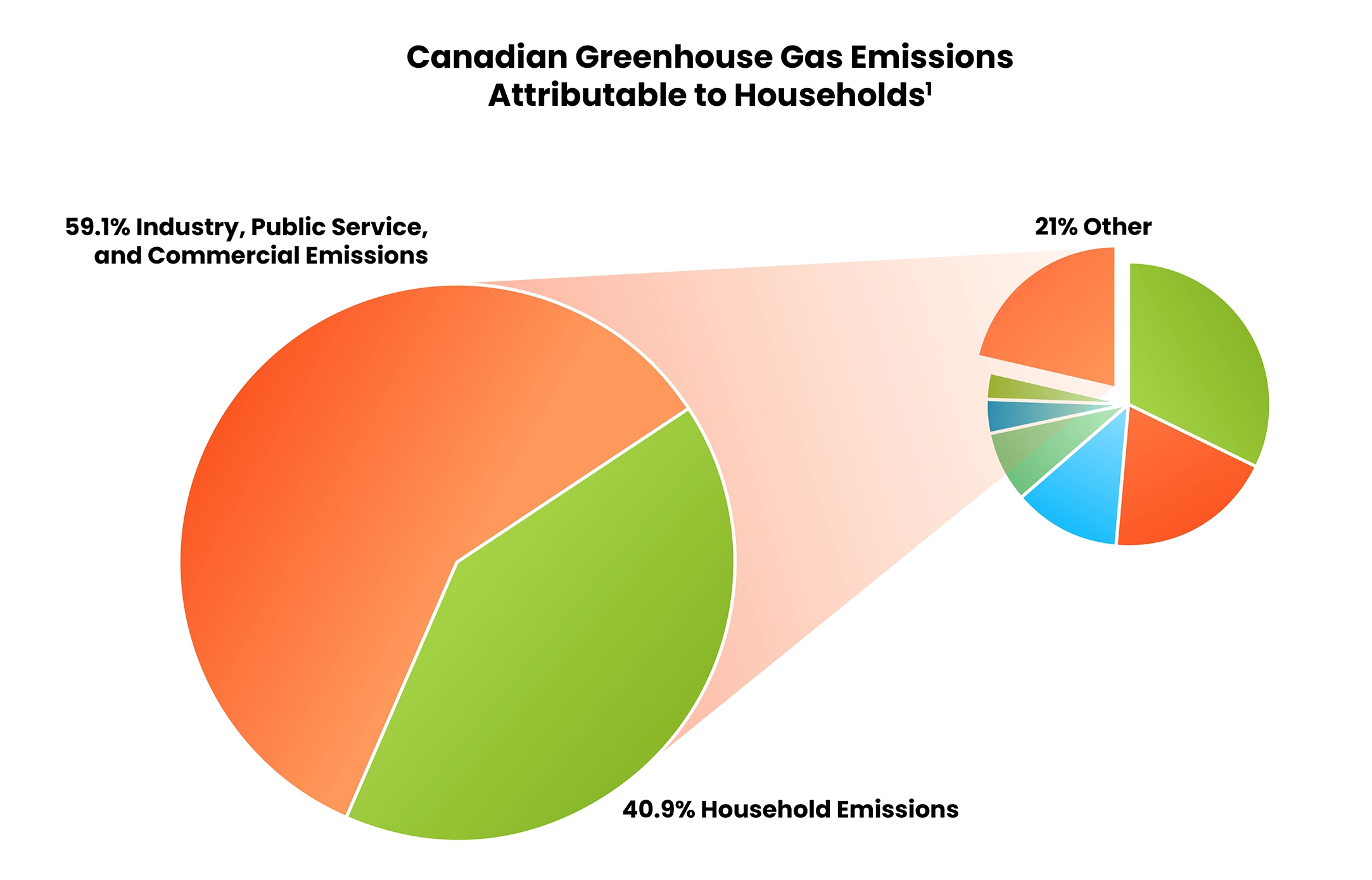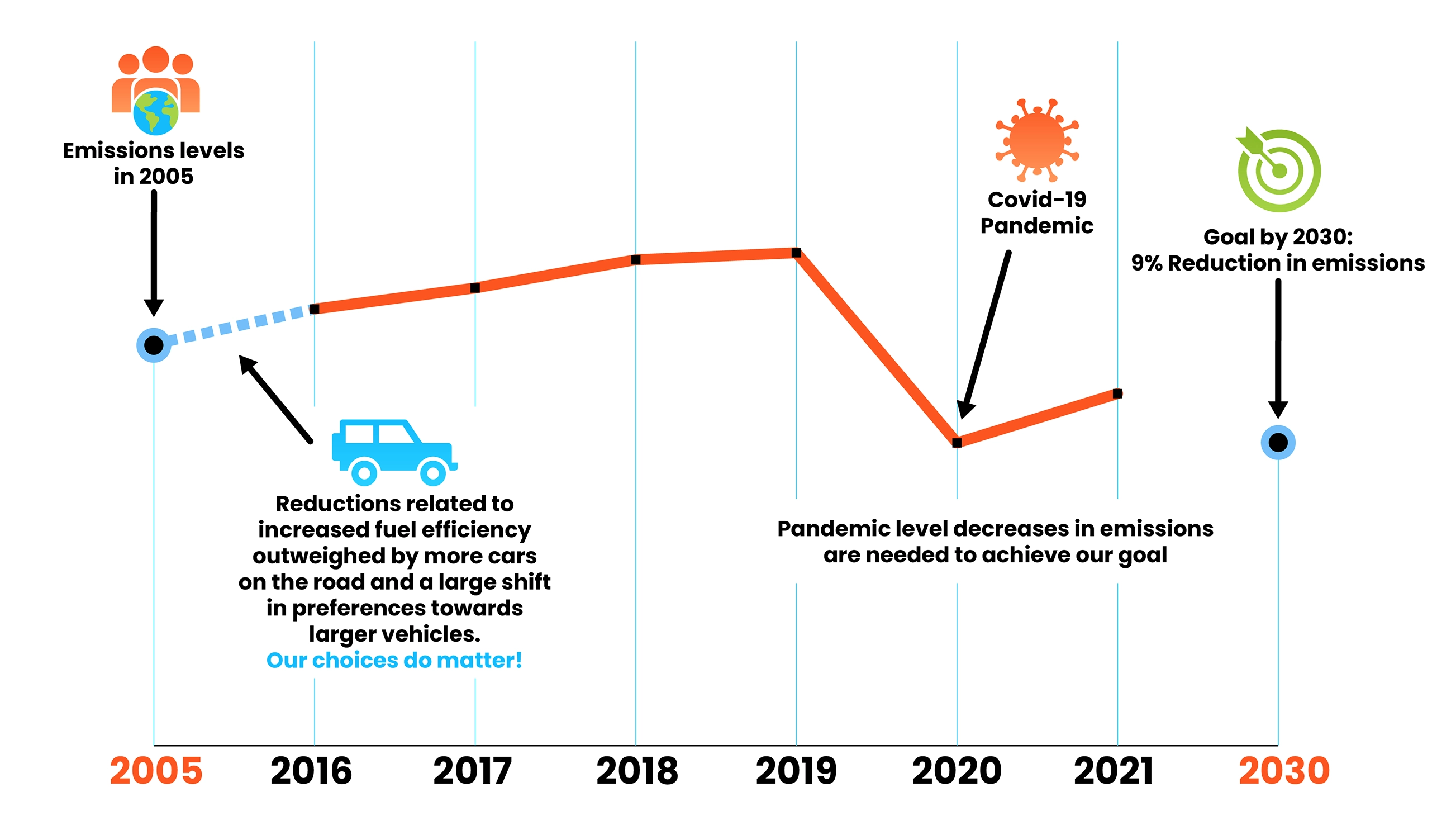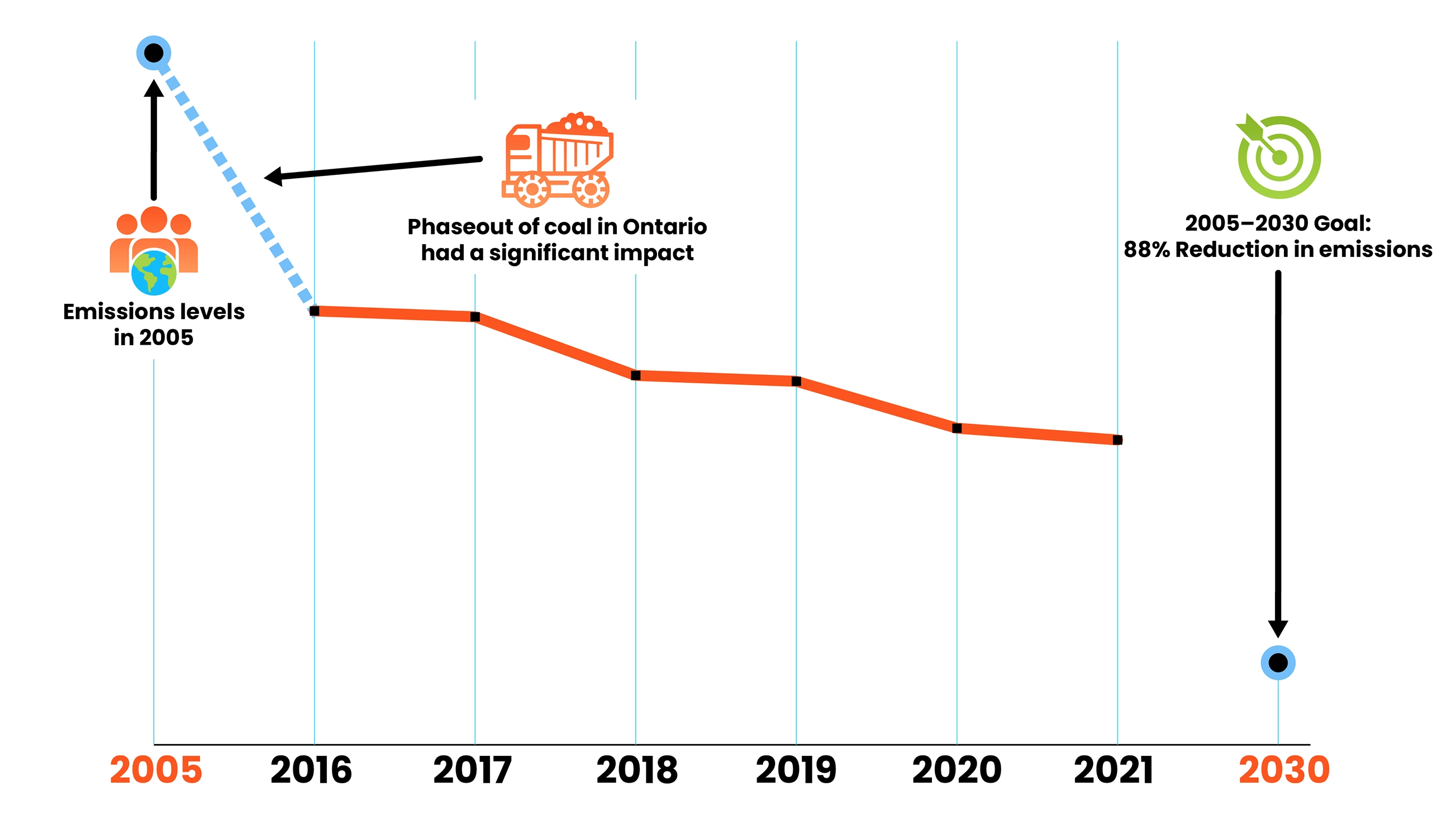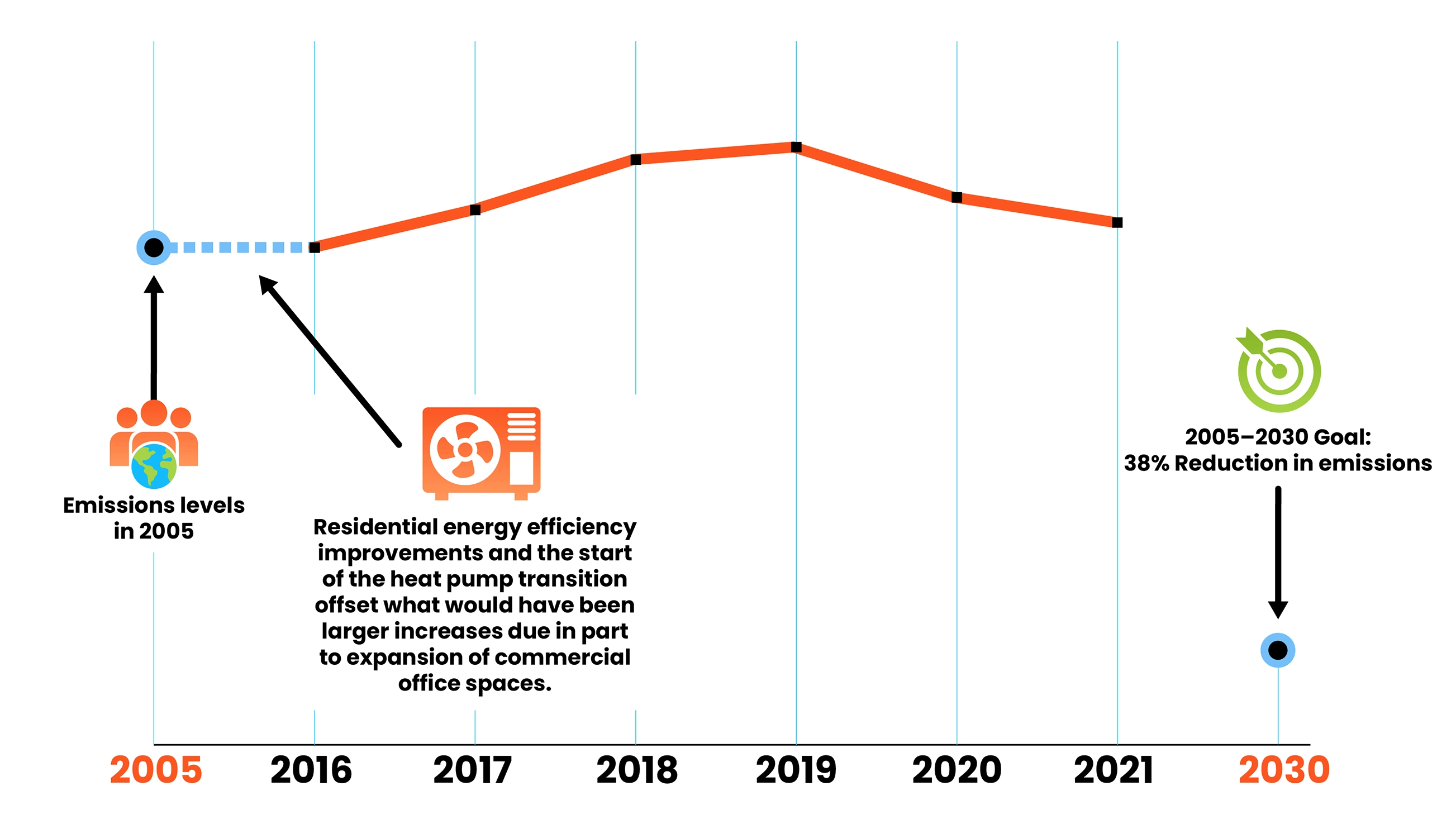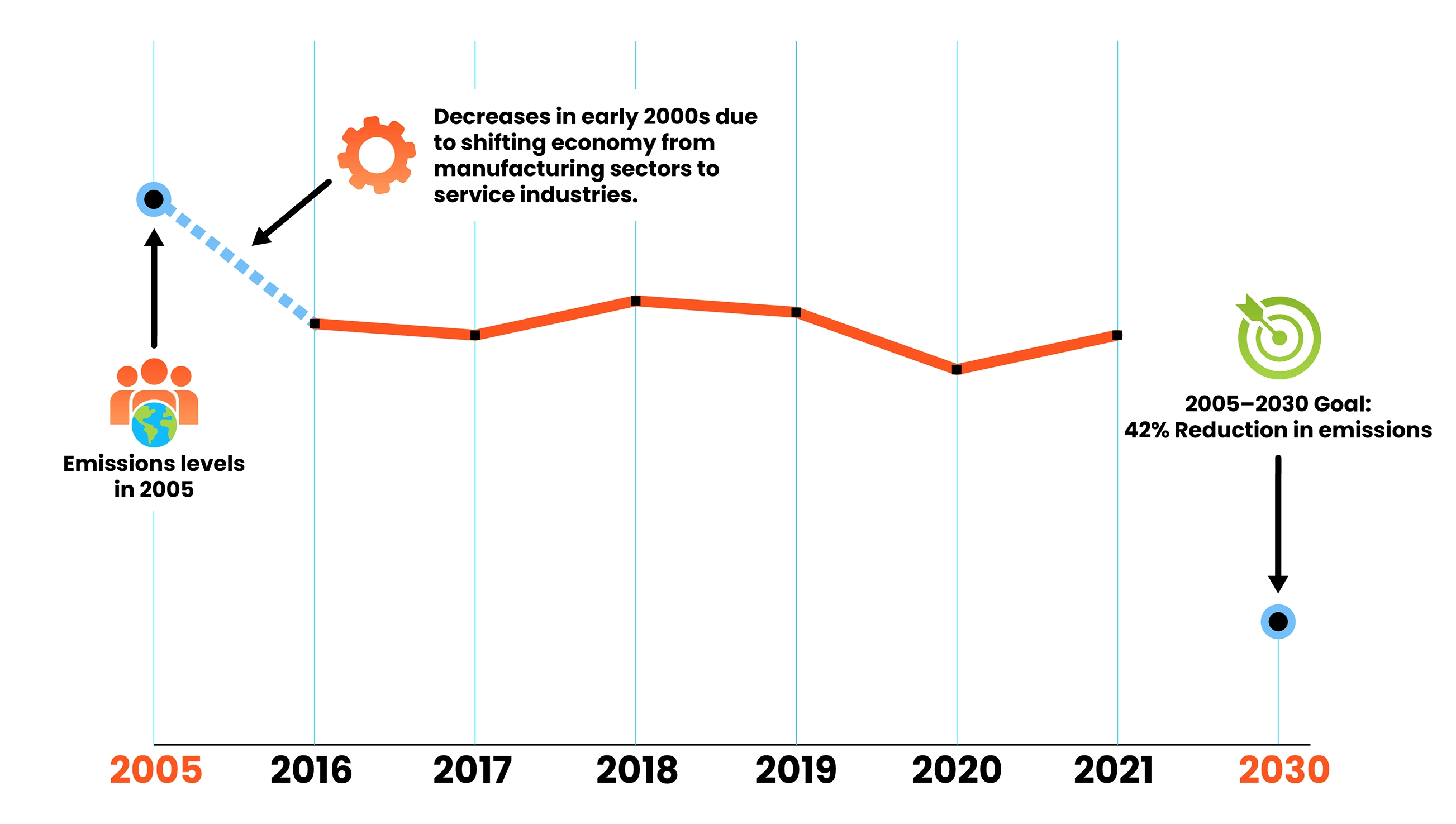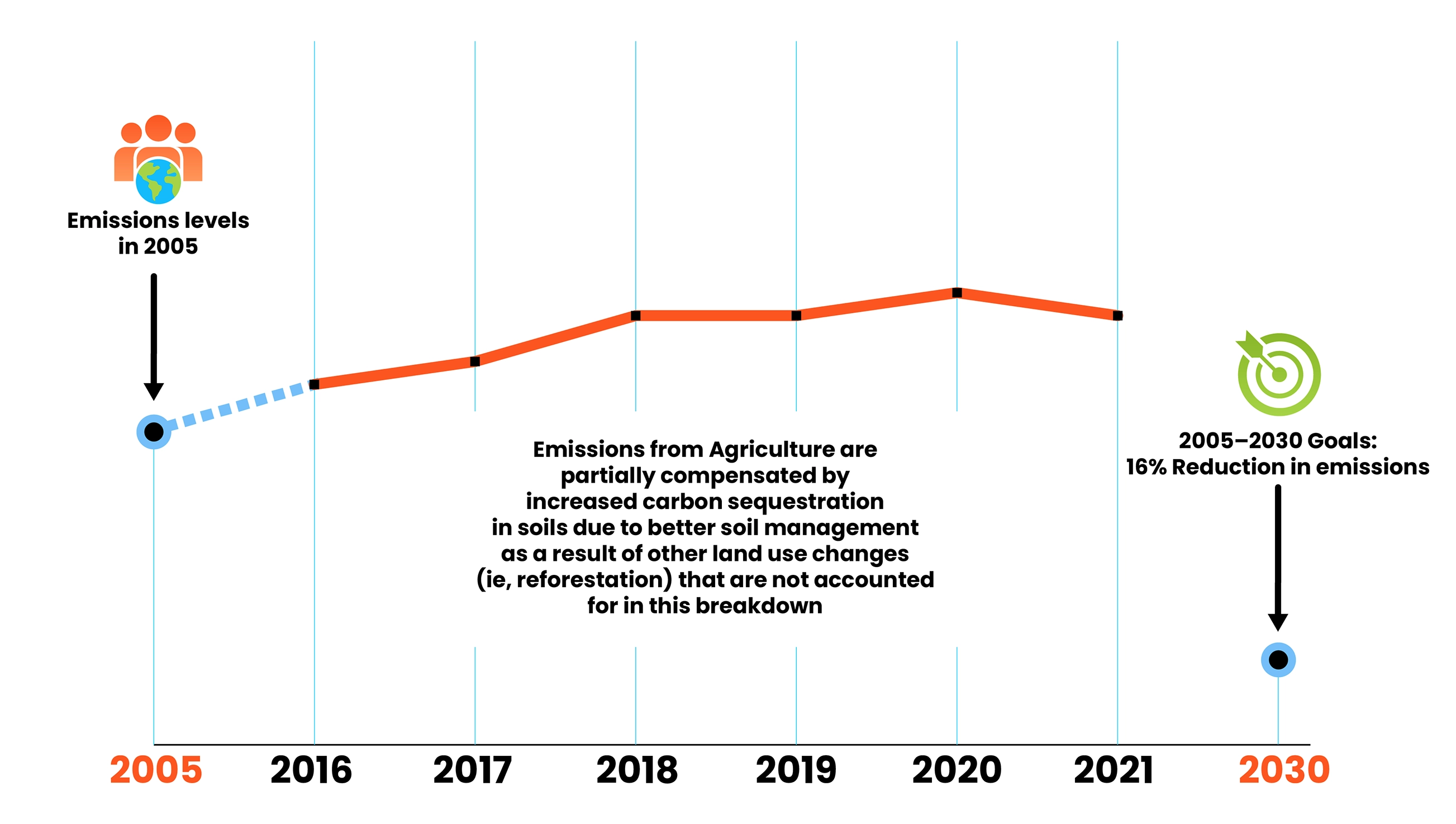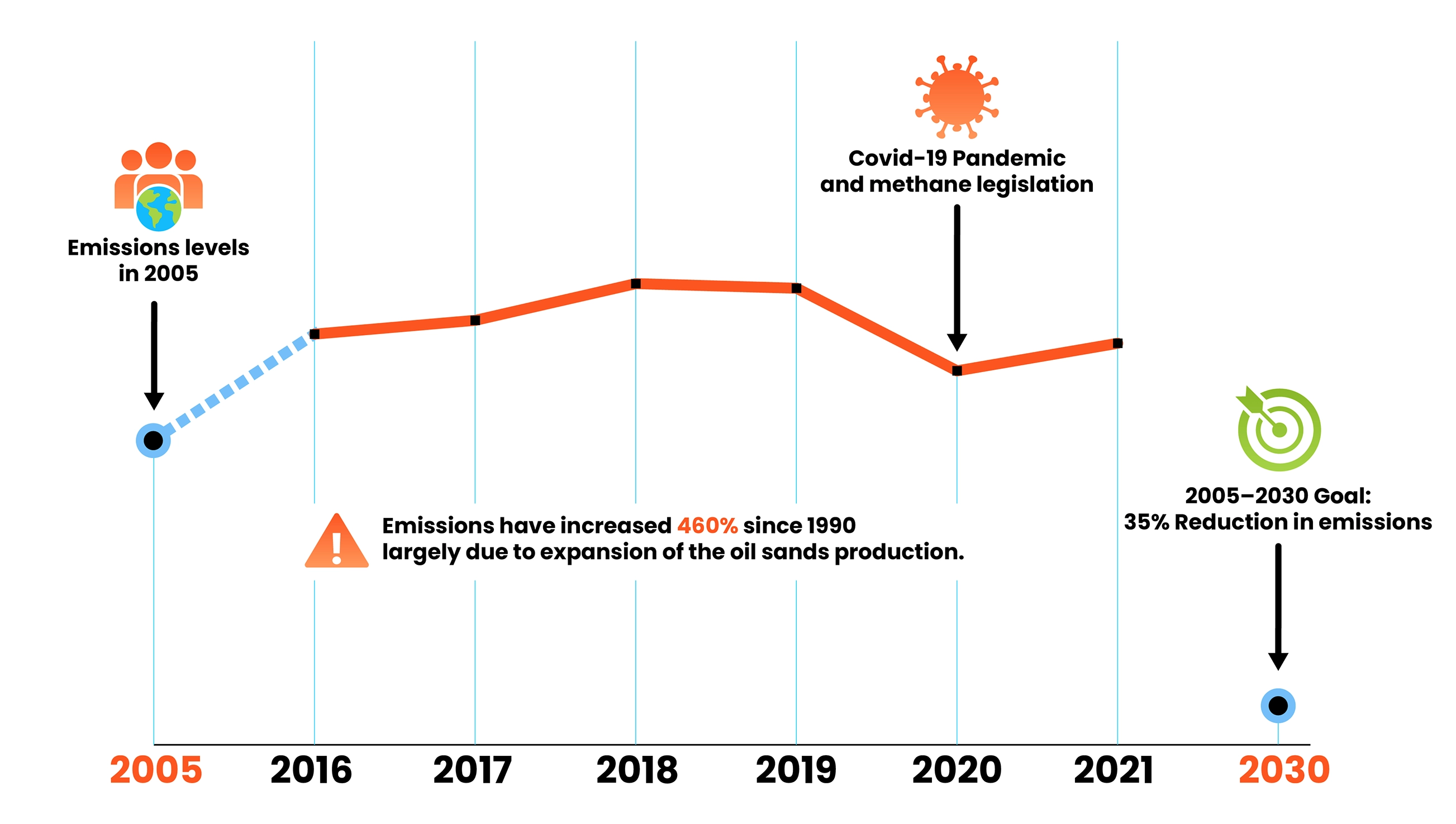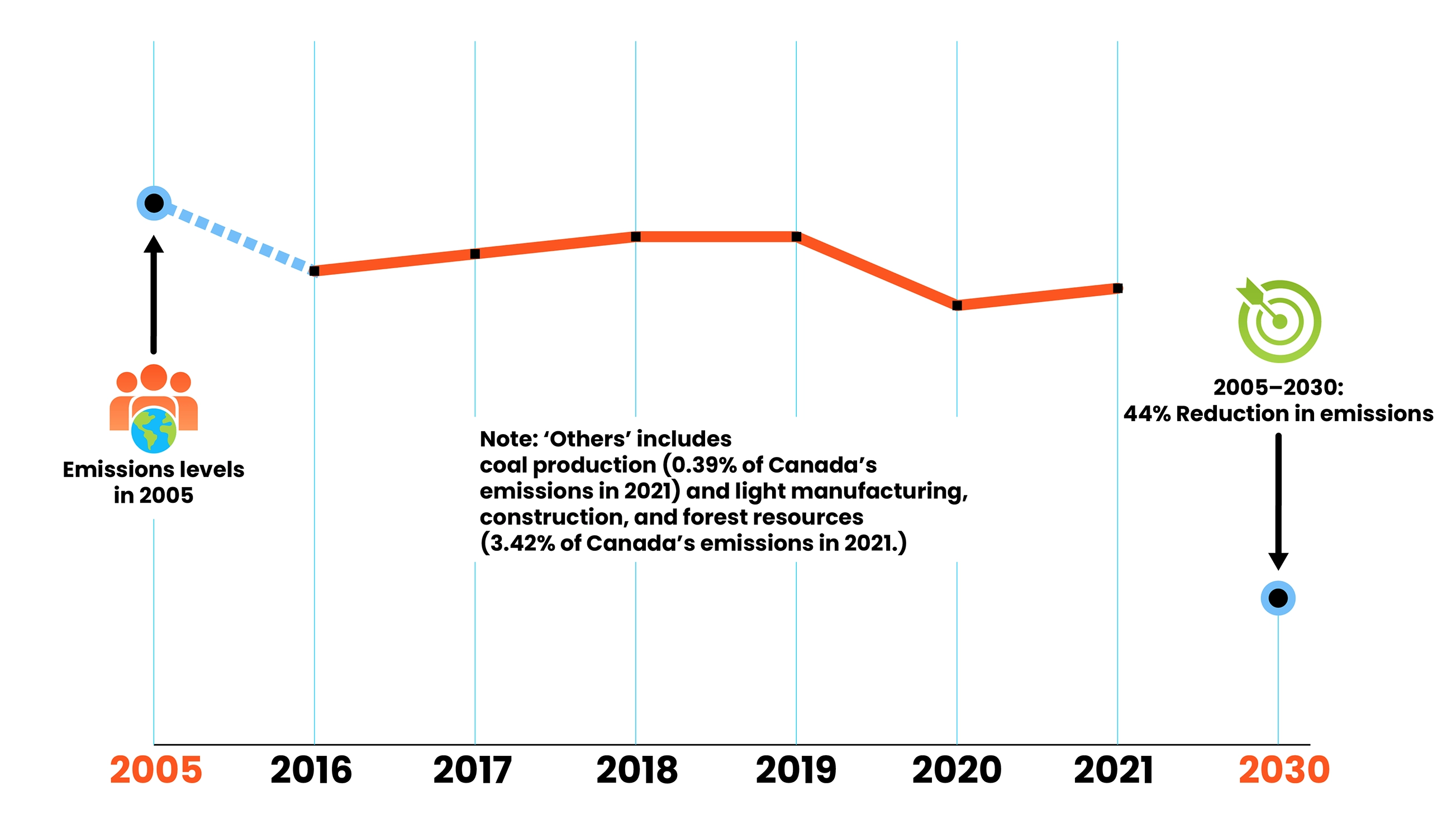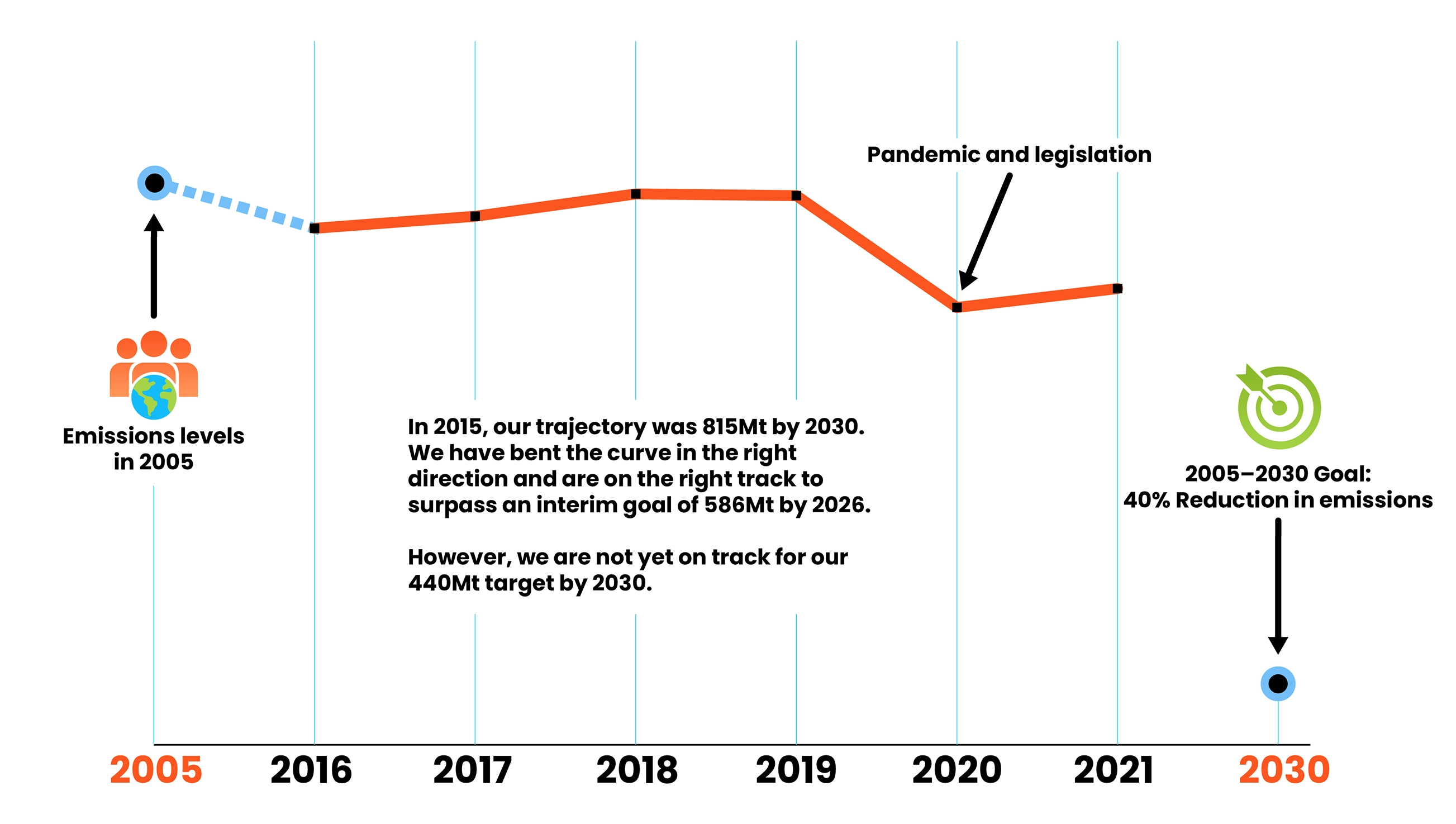Areas of Action: The Rest of Your Per Capita Footprint
Canada’s per capita footprint is based on Canada’s GHG emissions overall, which includes commercial/industrial and governmental emissions as well as household emissions. Understanding our emissions in light of this bigger picture helps to contextualize individual action and also highlights opportunities to drive broader systemic change through our consumption, our voices, and our votes.
What needs to change?
• High-emissions dependent economy
• Low-emissions economy, strong clean economy, a just transition for impacted sectors, decoupling of GDP (i.e. economic growth) from emissions
Why is this so important?
Household emissions account for about a fifth of Canada’s emissions. But actions that reduce household emissions also help to drive the other 80% down by supporting the shift in Canada’s economy towards clean energy and putting our weight behind the broader initiatives being undertaken.
Overall, reducing demand for fossil fuels and increasing demand for clean energy is the most direct impact you can have in reducing your footprint and reducing global warming. But other sustainable initiatives are important as well.
Understanding a little bit about the bigger picture of the Net Zero transition in Canada reinforces the importance of supporting government action towards financing the transition, supporting a just transition for impacted workers, supporting hard to abate sectors and a profitable, regenerative agricultural sector, and developing our strategy to phaseout unabated fossil fuel emissions.
Why so urgent?
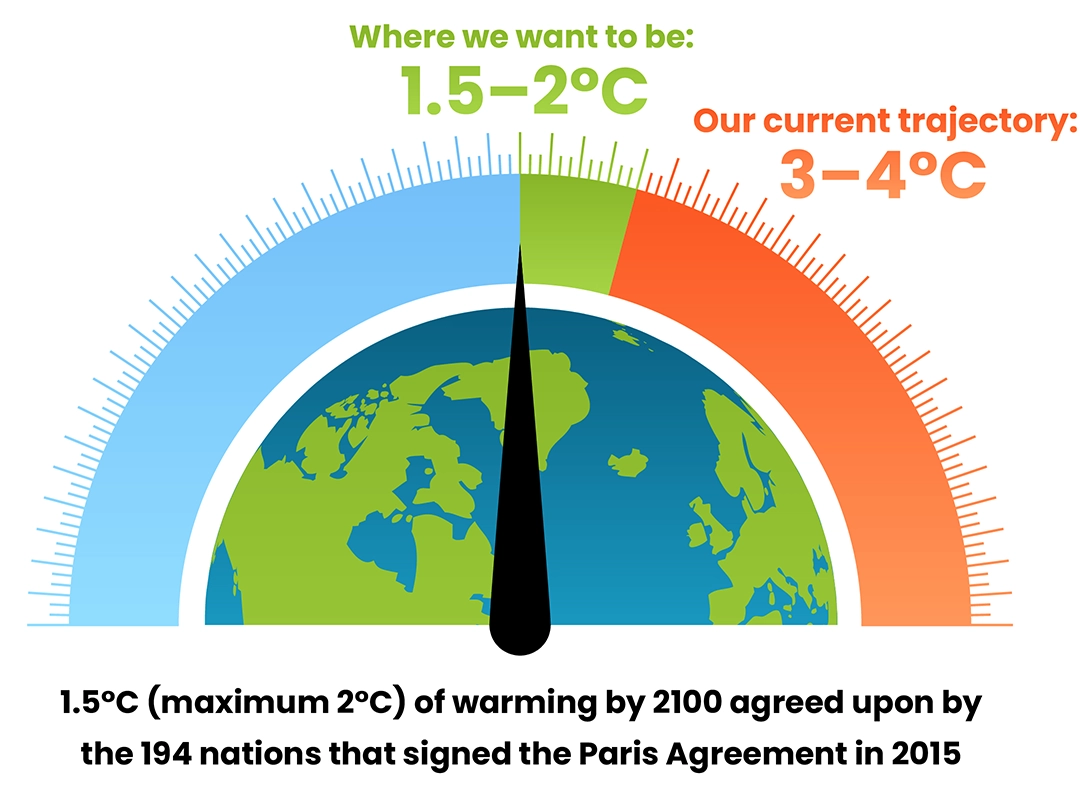
There is a rapidly narrowing window of time to implement existing commitments and raise ambition2. See Why So Urgent?
As per the Paris Agreement and subsequent IPCC modelling and research updates, we need to reduce our emissions by 43% below 2019 levels by 2030 in order to have a good chance of hitting Net Zero emissions by 2050 and avoiding the worst impacts of climate change.
Our per capita footprint relative to the rest of the world
Canadians have one of the highest per capita footprints in the world3.

of countries have lower per capita footprints than Canada4 including other large and/or cold climate countries. Along with the United States and Australia, the other high emitters include oil states in the Middle East and some small island countries.
Greenhouse gas emission sources in Canada
You are reading this right — about one third of our Carbon Footprint is just in the extraction, production, processing, and transport of oil and gas. Not the end uses of fossil fuels.
How are our reduction efforts going?
The federal government, provincial governments, and municipalities collectively have hundreds of initiatives aimed at emissions reductions across all of the major sources referenced above.
Some have been implemented or are ongoing while many others are in earlier stages of consideration, development and initiation. The latter set emissions projections but have not had a concrete impact on emissions reduction yet.
The success of these government initiatives absolutely depends on our support, through our votes, voices, and behaviours.
So far, we have reduced our per capita emissions from

in 2005
to

in 2021
And we have reduced our total emissions from

in 2005
to

in 2021
(637 Million tonnes if land use changes that sequester carbon are included)
The goal to keep

alive is

in 2030
Importantly, we have decoupled our emissions from our economic growth (measured as GDP.)

per $Billion GDP
2005

2021
This means that our economic prosperity is not dependent on fossil fuel energy. Our economy is shifting to one that is supported by clean energy without sacrificing growth and prosperity.
And beyond that, Canada is well-positioned to make clean energy an important driver of our economy — particularly in the clean sustainable supply chain for, and production of, EVs.
Progress within the main sectors
Transportation Sector

We can do this if we…
• Drive less
• Switch to EVs
• Fly less
• Support electrification of public transportation
• Support infrastructure for more public transportation and active transportation
• Support hybrid work
• Support EV sales mandates
• Encourage governments and companies to offer clean transportation incentives, etc.
Electricity Sector

We can do this if we…
• Support the clean grid legislation and the transition to renewable/clean energy
• Support solar and vehicle to grid advancements
• Reduce demand by increasing energy efficiency
• Encourage similar changes at work where you shop, in your community, etc.
Buildings

We can do this if we…
• Electrify space and water heating with efficient cold climate heat pumps
• Make our homes more energy efficient
• Support hybrid work and shared work spaces to reduce the pressure on commercial space expansion
Heavy Industry

We can do this if we…
• Support legislation that helps heavy industry transition to clean energy and the development of low-carbon industry
• Support circular production
• Support green steel and cement
• Help compensate for a slower transition in hard to abate sectors with a faster transition in the sectors with solid solutions
Agricultural Sector

We can do this if we…
• Support regenerative agricultural practices
• Support government funding to support the transition for farmers (manure management, decreased fertilizer use etc.)
• Increase plant-based, poultry, and pork consumption over beef. If you eat beef, choose locally raised, grass-fed cows.
• Support farmers by increasing reductions in other areas
• Support tree planting
Oil and Gas Sector

We can do this if we…
• Support emissions cap legislation
• Support carbon capture utilization and storage tax credit (ITC)
• Help pressure the industry to close up abandoned wells
• Support the carbon tax (which uses the polluter pays principle and provides individuals with a rebate)
• Reduce demand for oil and gas by switching away from fossil fuels
• Support a just and sustainable transition for fossil fuel sector workers (about 0.5% of Canada’s workforce) and supporting industries (e.g. pipeline construction—another 0.5% of Canada’s workforce)
Waste and Others

We can do this if…
• Reduce waste to landfill by adopting circular economy principles into your lifestyle and consumption habits
• Support methane recycling from landfills for use as heat/fuel
• Support government initiatives to phaseout the residual use of coal
• Support reforestation
• Sustainable construction/renovation and sustainable forestry practices
Emissions Totals
The impacts of recent government initiatives and private sector investment/action will tip the curve downwards but not enough. Imminent shifts in society are both a part of the current downwards projections and, if we act more quickly than projected, can get us to the goal.
We need an all hands on deck effort to the curve down as close to 440 Mt as possible. Civil society matters. Public opinion and support of government action matters.
If we had not implemented initiatives over the last 2 decades and had no plan, our emissions were projected to rise to over 800Mt CO2eq by 2030. We have to acknowledge as well, that it took a global pandemic to make an impact in the right direction in some sectors.
If we keep all of the existing initiatives and implement the ones that are under consideration, in development/review, or have recently been initiated we can almost hit the goal. And with a little additional effort we can actually reach our global commitments6. The closer the better.
Just as we — albeit inadvertently — increased emissions over time as one by one we switched to natural gas, bought bigger cars, travelled more, ate a less sustainable diet, bought Fast Fashion etc., we need to reverse the trend.
One by one we need to transition to a clean and sustainable future — knowing that some other people have already paved the way and that more will follow.
This is the journey. It is a whole of society transition that involves all of us. Choose your own adventure, but we are all heading to the same clean energy future. We can act quickly and move towards a clean sustainable future (limiting the damage to ‘worse than today’, but something we can adapt to, maintain prosperity and land in a more sustainable and respectful place), or we can delay and transition to a clean but chaotic future with irreversible and potentially catastrophic damage (far worse than today but not extinction level at least for humans.) What legacy will we pass on to our children?
Ready to get started? Build a plan that works for you here.

References
References
1. Lang, T., Li, G., & Mattie, S. (2022, March 28). Data for Canadian Greenhouse Gas (GHG) emissions attributable to household consumption and use of select goods and services along with the associated emissions intensity figures and breakdowns by final demand categories. Government of Canada, Statistics Canada. https://www150.statcan.gc.ca/n1/pub/11-627-m/11-627-m2022003-eng.htm
2. United Nations Climate Change. (2023, September 22). Report: Challenges and Opportunities Identified During First Global Dialogue on Mitigation Ambition and Implementation. UNFCCC.int. https://UNFCCC.int/news/report-challenges-and-opportunities-identified-during-first-global-dialogue-on-mitigation-ambition
3. 2023 Progress Report on the 2030 Emissions Reduction Plan. Environment and Climate Change Canada. (2024, January 11). https://www.canada.ca/en/environment-climate-change/corporate/transparency/priorities-management/departmental-plans/2023-2024.html
4. Ritchie, H., Rosado, P., & Roser, M. (2023, December 28). Per capita, national, historical: How do countries compare on CO2 metrics?. Our World in Data. https://ourworldindata.org/co2-emissions-metrics
5. Environment and Climate Change Canada. (n.d.). National Inventory report 1990–2021: Greenhouse Gas Sources and Sinks in Canada. UNFCCC.int. https://publications.gc.ca/collections/collection_2023/eccc/En81-4-2021-1-eng.pdf
6. Government of Canada. (2024, April 10). Greenhouse gas emissions projections. Canada.ca. https://www.canada.ca/en/environment-climate-change/services/climate-change/greenhouse-gas-emissions/projections.html


